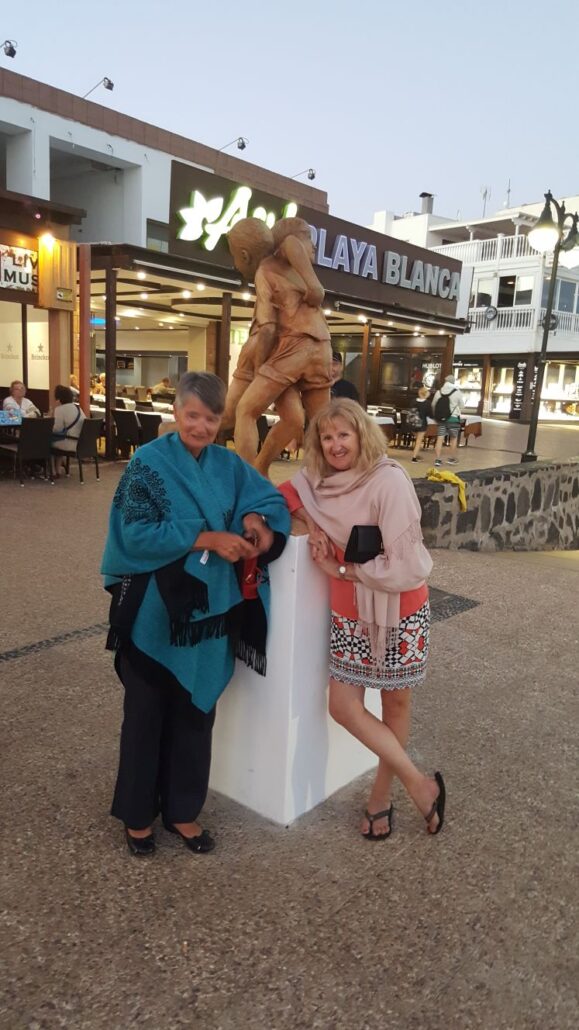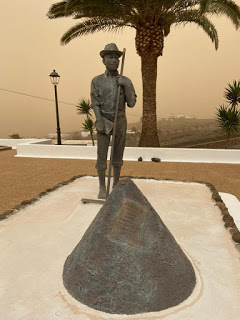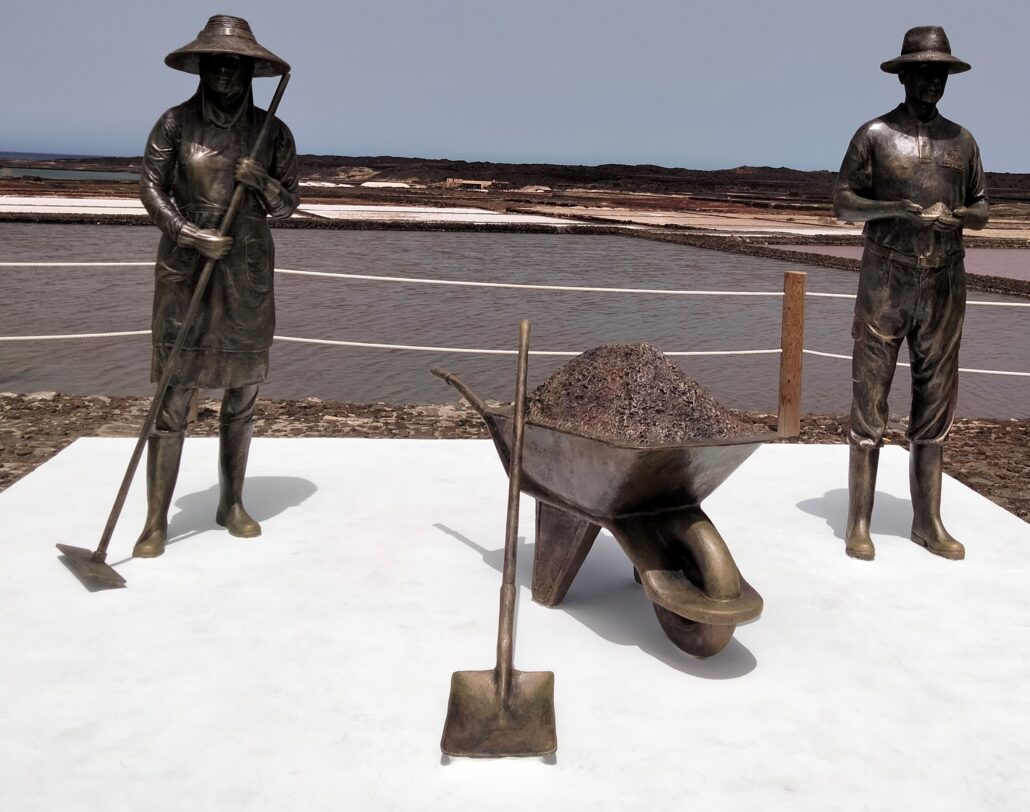STANDING STATUES, STILL, TELL STORIES
STANDING STATUES, STILL, TELL STORIES
by Norman Warwick
Michael Higgins, our cultural historian correspondent from the North West of England posted Statues Standing Still Reflecting, in June 2020, in thorough discourse on that subject. In April of this year Michael also heard the unseemly outcry about The Mary Wollstencraft statue that became known as Frankenstein´s Granny a few months ago, and you can find that too by entering Michael´s name in the search area of our archives. It is interesting to note, too, that Lazarote G Life, one of the island´s glossy monthlies has, in its recent May edition, highlighted one or two statues, even on the island, of people who have been revealed by history to be something less than the heroes they were once thought to be.

The President Presents Plaque To The Sculptor
The president of the Cabildo (government) de Lanzarote, María Dolores Corujo, inaugurated this Friday a sculptural group in homage to the salineras and salineros.
The organization by Salinas de Janubio, SL, wanted to recognize this work over more than a century, with the work of the artist. She is a young artist from Lanzarote who, through sculpture, perpetuates a past we must never forget.
I am indebted to a piece on InfoNortedigital.com for reminding me that every year since 1975, the UN has held an International Day to commemorate and celebrate working women. Each year the United nations nominate a woman who has excelled in the world of folklore and the traditions of our islands, well-versed women, runners of wisdom and experiences.
A couple of years ago InfoNorte interviewed artist Cintia Machín Morín, a native of the municipality of Yaiza on the island of Lanzarote, as being an artist who similarly celebrate working women.
The interview was apparently conducted over the phone but on reading it I found it a very interesting interview well worth integrating with the scores of pages, both here on Lanzarote Information and on my own Sidetracks And Detours daily blog site, that I have delivered about the statues around the island, including some of Cintia´s previous work, such as the wrestlers at Playa Blanca and El Gopar in Las Brenas. We have also reported directly on a couple of occasions from the area of Salinas de Janubio, including an interview with Sally In The Hat (see Norman´s archives)and ion last week´s article about new development plans for the region.
Even on the phone to InfoNorteCintia comes across as a person of the humility, maturity and awareness, typical of people with much more experience she was only 24 years old, in 2020, the year of the interview.

with her well known ´wrestling stature
She spoke though, with great pride in her beginnings, as she remembered her childhood in the area of La Salina de Janubio, in Yaiza. She started in the art world from a very early age, copying great artists such as Velázquez, That realistic copying has been a great influence on her career and that it has helped her to perfect the style she possesses and that she defines as realistic. In her time in compulsory education, Cintia entered art competitions in which she obtained prizes for her works, motivating her to continue in following her art, so she decided to study Fine Arts at the Complutense University of Madrid.
The Canarian school of art has been of vital importance to study art in our islands, so Cintia names as a reference the late Lanzarote artist César Manrique.
Rigoberto Camacho is another of the outstanding artists for her, and she offered an impressive appreciation of his work, saying it had given her the opportunity to learn from him in his workshop, with an artist working in the same genre, had added value in her training, sharing both the same style.
photo cintia with wrestlers We could joke that like many students in these days of paid for studies, Cintia left university with no more than a loaf of bread under her arm, although she actually finished her studies she was commissioned by Gladis Acuña, the then mayor of Yaiza, for the realization of a public monument to reference the Canarian struggle. La Cantera, the title of the subsequent work, is a sculpture of 2.20 meters high and 60 kilos of weight, which represents two young ´fighters´, with which Cintia makes us see the innocence of the children, since one of the fighters has a hand on the back of his rival incorrectly and has lost his grip. The work was inaugurated in February 2018 and with it Cintia saw a dream fulfilled. It was at that moment she realised her career was in progress as the commission and her ensuing work served as an endorsement and showcase to show her artistic talents and ethos.

never ones to miss a photo op
With her obviously innate humility Cintia is proud that this sculpture is an attraction on the promenade of Playa Blanca, being one of the places where visitors are photographed the most. Actually my wife Dee and I often sit in the Mia bar nearby, doing our crossword, and we always see at least one family or group of tourists taking a photo op.
Another work by Cintia has been located in the Plaza de Las Américas of San Sebastián de La Gomera since September 2018, coinciding with the celebration of the Columbian festivities the statue of Christopher Columbus is inaugurated, which has been one of the most outstanding personalities in the history of the conquest by the Castilians of La Gomera and the Canary Islands as a whole.

More recently the municipality of Yaiza recognized the great value of one of its most outstanding neighbours dedicating a statue of Víctor Fernández Gopar “El salinero” (1844-1920), who also has a theatre named after him in Arrecife. Cintia, very proudly told InfoNorte that she felt predestined to be the architect of this work. She told her interviewer that she was born only a step away from the Salina de Janubio and about the views she has from her workshop and her house to the salt pans. In addition to being knowledgeable of many Gopar couplets, having taken being part in the Festival of Seguidillas that celebrates the man known as El salinero” with the parranda Janubio. All of this was obviously an inspiration of the artist to make the sculpture.
The work has a height of 2.40 meters and a weight of 90 kilos and is already exposed in the Plaza de Las Brenna’s in the municipality of Yaiza. It was not easy to put a face and body to Víctor Fernández Gopar because there were no photographs of him.
In the absence of graphic material on the figure of ‘El Salinero’ that showed any physical or facial trait that helped to model his figure, Cintia made a reconstruction from the data collected in the investigation of the oral tradition and the information provided by his relatives.
We attended the unveiling of that particular statue in Las Brenas, with friends Iain and Margaret who live up there. It was a day, considerably pre-covid, that seemed equally as apocalyptic. The calima was so dense that you could not see a hand in front of your face, let alone a statue across the town square. All the speeches had to ´brought inside´ and as is the way on Lanzarote everybody joined in passing about four hundred chairs from the square into a hall, then the tables, then the drinks, then the food, and then the microphones. As is the way on Lanzarote all social graces occurred under cover and took an hour or so before we all, as is the way on Lanzarote, all trooped out to stand toe to toe with the statue to take photographs that all turned out spoiled by the calima. I reported on all this in my usual brief and understated way in Lanzarote information and on my Sidetracks And Detours blog.
From Cintia’s point of view, sculpture unites the three artistic bases that are: drawing, volume and painting. In her works she respects the fundamental bases of painting. Although she is knowledgeable in the world of drawing and painting, she is not engaged in work on pictorial works.
Catholic religion was instilled in her by her parents throughout her childhood, which is why she dreams that one day she might be able to make some religious image.

As an artist she likes to finish what she starts, so if at the time any of her projects is stagnating, Cintia leaves it for a while, and then regains impetus, by re-approaching the work and asking figuratively ´What is it that you lack? Tell me, so that I may give it to you”.
Cintia believes that the art world is very difficult, and that an artist has to achieve an economic balance. She feels fortunate and privileged to be able to make a living by working at what she likes doing. She is very aware that not everyone has that same opportunity…
She is very appreciative of the recognition of her municipality and its people, which is not easy in the art world. The ´borough´ of Yaiza has always supported her and reached out when he has needed it.
I was a community artist working in Rochdale for many years in the UK. In what was an otherwise deprived borough it was fantastic to enjoy all kinds of support from a council, of whatever political colour, always had a programme of revenue funded arts organisation to help re-shape and improve the town. These included Spiral Dance on which my wife and I were trustees, Just Poets, my performance poet an creative writing team with Pam McKee and my all across the arts programme with Steve Bewick on Crescent Community Radio. Enjoying, and benefitting from such close links to the council could have caused some conflicts of interest but I strongly suspect that Cintia has exactly the right balance of humility and independence in her soul and that her work will continue to benefit her community.

Cintia describes herself as ´somewhat dreamy and with very ambitious projects´, and would like her personal and public work to be able to leave the borders of our islands and participate in art festivals at national and international level.
Meanwhile, I second InfoNorte in congratulating Cintia on a professional career that has had such an auspicious opening few years. As InfoNorte suggest, that career has, since its inception, been linked to the Canarian identity. She deserves so much credit because craftsmanship is one of the fundamental pillars of her works; for being a young woman who has opted for a world as difficult as art and above all for trusting herself and being able to dedicate herself to what she likes.
Here on the solid platform of Lanzarote information, and down the sidetracks & detours for my own daily blog, we will continue to follow Cintia´s career. No doubt our media friends at Lancelot Digital and in the island´s glossy life style magazines will do the same. She deserves our attention and I suspect will repay us handsomely with continuing achievements.

Meanwhile President Corujo affirmed, after uncovering the sculptures at Salinas De Janubio (left) that ´today there is a recognition of centuries of history, the uniqueness of our landscape, (and these works represent) an endearing and fair tribute. He, who does not recognize his people, does not recognize his history. Salinas de Janubio, in addition to being the most important salt flats in the Canary Islands, is undoubtedly a symbol of the work of many women and men´.
The commemorative plaque together with the sculptural group reads as follows: ´In recognition of the salineros and salineras of Janubio and Francisco Pardon Viñas (1921-2013) for their contribution to the cultural space of the Salinas de Janubio´.
These pieces are the realisation of an initiative set in motion by Carlos Padrón, who represents the third generation of owner-producers in Janubio, a space in which sea salt has been produced uninterruptedly since the end of the 19th century.
The sculptural piece also pays tribute to Francisco Padrón Viñas, father of Carlos Padrón and a Yaiza doctor since 1949, who dedicated a large part of his life to the production of artisanal sea salt in Janubio.
Carlos Padrón highlighted that ´the sculpture seeks to recognize the contribution made by many families in the production of sea salt by artisanal methods, which has allowed conserving these salt flats, which are the largest and most valuable in the Canary Islands´.
The event was also attended by the vice president of the Cabildo, Jacobo Medina, and several councillors of the island institution, as well as the mayor of Yaiza, Óscar Noda, who expressed his desire that this valuable space can recover the scenic splendour that it had before the fishing sector, a vital customer for the salt until refrigeration became widely available and prevalent.
Certainly these statues of Cintia´s, being well chosen, well crafted, well explained and well sited, are unlikely to suffer the same indignities as so many statues around the world, and in The UK particularly.




Leave a Reply
Want to join the discussion?Feel free to contribute!